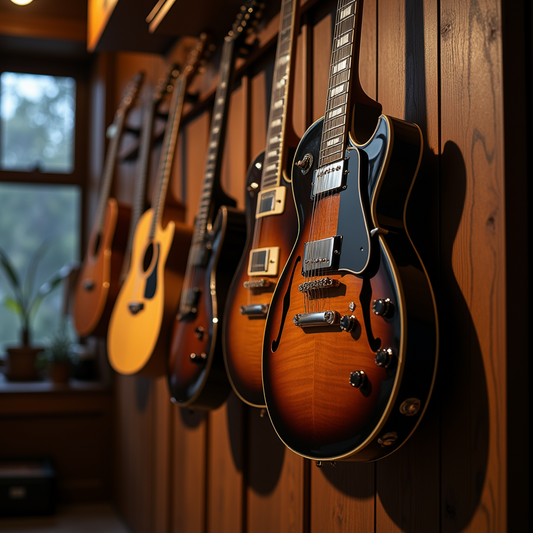How to Choose Your First Acoustic Guitar as a Beginner: A Step-by-Step Guide
Share
Introduction
Choosing your first acoustic guitar is an exciting step in your musical journey, but with so many options available, it can feel overwhelming. As a beginner, you want to pick a guitar that fits your budget, playing style, and comfort level, while also offering great sound quality. In this guide, we’ll walk you through the key factors to consider when selecting your first acoustic guitar, so you can start strumming confidently and make the right choice for your musical goals.
1. Set a Realistic Budget
Why Budget is Important When you're new to guitar playing, it’s important to find a balance between quality and cost. Acoustic guitars come in a wide range of prices, from budget-friendly beginner models to professional-grade instruments. Setting a budget will help you narrow down your options and avoid spending more than necessary.
-
Entry-Level Guitars ($100 - $300): These guitars offer great value for beginners. They are typically made with laminated woods but are still durable and provide decent sound quality.
-
Mid-Range Guitars ($300 - $600): These guitars often use solid woods, which produce better sound and resonate more clearly. They may have improved playability and durability.
-
High-End Guitars ($600 and up): High-end guitars are often built with premium tonewoods and offer superior sound quality. While not necessary for beginners, these can be great investments as you progress in your playing.
Key Tip: For most beginners, an acoustic guitar in the $150 - $300 range offers the best combination of affordability and quality.
2. Choose the Right Body Size and Shape
The body size and shape of an acoustic guitar directly affect the sound it produces, as well as how comfortable it is to play.
-
Full-Size Dreadnought: This is the most popular body shape, known for its loud, full sound. It’s a great all-around choice for beginners who want versatility.
-
Concert and Grand Concert: These guitars are slightly smaller and offer a more balanced, midrange-focused sound. They’re often preferred by fingerstyle players and those looking for a more comfortable instrument.
-
Parlor and Travel Guitars: These are smaller guitars, perfect for players who want a more compact instrument. They are easy to handle and ideal for practicing on the go.
-
Grand Auditorium: A hybrid between a dreadnought and a concert guitar. It’s great for a wide variety of styles, offering both projection and warmth.
Key Tip: If you’re just starting out, a dreadnought or grand auditorium style is usually the best option for its balanced sound and versatility.
3. Consider Tonewoods
Tonewoods are the woods used in the construction of your guitar, and they play a crucial role in shaping the guitar's tone. Here are the most common tonewoods and how they influence sound:
-
Spruce: The most common top wood for acoustic guitars. It provides a bright, clear sound with plenty of projection. Great for beginners due to its versatility.
-
Mahogany: Known for its warm, mellow tone, mahogany is often used for the back and sides of guitars. It’s great for fingerstyle players and those looking for a more intimate sound.
-
Rosewood: Typically used for the back and sides, rosewood offers a rich, full sound with complex overtones. Guitars with rosewood back and sides are known for their deep bass and bright treble.
-
Laminate vs. Solid Wood: While solid wood guitars are more expensive, they offer better resonance and sound quality. Laminated wood guitars are more affordable and still a great option for beginners.
Key Tip: Look for a solid spruce top guitar for the best value and versatility, as it offers a bright, clear sound that works well with many styles.
4. Check the Neck and Playability
The playability of an acoustic guitar is crucial, especially for beginners. You want a guitar that feels comfortable in your hands and is easy to play.
-
Neck Shape: The neck should be comfortable for your hand size. A C-shaped neck is the most common and works well for most players.
-
Scale Length: The scale length is the distance between the nut and the bridge. Shorter scale lengths (like those found on parlor guitars) generally make it easier to press down on the strings and play.
-
Action: This refers to the height of the strings above the fretboard. Guitars with high action can be harder to play, especially for beginners. Look for guitars that are set up with low to medium action for easier fretting.
-
Fingerboard Material: Common materials for fingerboards include rosewood and ebony, both of which are smooth and comfortable to play.
Key Tip: When trying out guitars, pay attention to how the neck feels in your hand and whether the strings feel easy to press down. If the guitar feels too hard to play, it may not be the best fit for a beginner.
5. Consider the Guitar's Sound
As a beginner, you may not yet be able to fully appreciate the nuances of different acoustic guitar tones, but it’s still important to listen closely when trying out different guitars. The best guitar for you will have a tone that resonates well and is pleasant to your ears.
-
Brightness vs. Warmth: Guitars with spruce tops tend to be bright and clear, while those with mahogany or rosewood offer a warmer, more rounded tone.
-
Volume and Projection: Pay attention to how loud and resonant the guitar is. Dreadnought and grand auditorium guitars generally offer more volume and better projection.
Key Tip: Listen for a clear, balanced sound that is comfortable for you to play. If the guitar sounds too muddy or unclear, it might not be the right fit.
6. Look for Additional Features and Accessories
When buying your first guitar, there are a few additional features and accessories that can help enhance your playing experience:
-
Built-in Tuner: Some acoustic guitars come with a built-in tuner, making it easier to keep your guitar in tune without needing an external tuner.
-
Cutaway Design: If you plan on playing lead guitar or soloing, consider a cutaway guitar, which allows for easier access to higher frets.
-
Starter Kits: Many brands offer starter kits that include the guitar, strap, picks, tuner, and gig bag. These are convenient for beginners who need all the accessories to get started.
Key Tip: Look for guitars with built-in tuners and starter kits to make tuning and getting started easier.
7. Popular Beginner Acoustic Guitars
Here are some popular and well-regarded acoustic guitars for beginners:
-
Yamaha FG800: A highly recommended guitar known for its great value, solid spruce top, and balanced tone.
-
Fender CD-60S: An affordable dreadnought guitar with a solid spruce top and comfortable playability.
-
Epiphone DR-100: A great entry-level guitar with a solid spruce top and easy-to-play neck.
-
Ibanez AW54CE: A solid mahogany acoustic-electric guitar with excellent tonal qualities.
Key Tip: Visit a local music store to test out these models and see which one feels and sounds best to you.
Conclusion
Choosing your first acoustic guitar is an exciting step, and with the right knowledge, you can make a decision that will inspire you to play for years to come. Consider factors like your budget, preferred sound, body size, and playability to find the perfect match for your musical goals. Remember, the best guitar for a beginner is one that feels comfortable and motivates you to keep playing.



